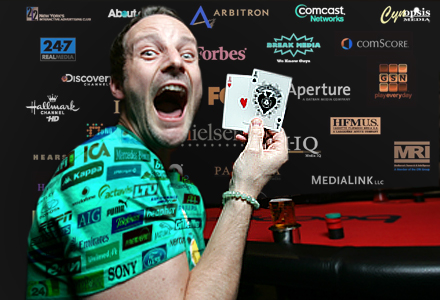 Not all that long ago I talked with an American musician who told me that he wanted to get sponsored to play poker whenever his band wasn’t on the road. He’d seen countless celebrities who were terrible at poker playing on television and he knew that, as someone who had made a living playing the game before his band took off, he would be a favourite if he could just get to the table. There was only one problem with his plan: he came along about five years too late.
Not all that long ago I talked with an American musician who told me that he wanted to get sponsored to play poker whenever his band wasn’t on the road. He’d seen countless celebrities who were terrible at poker playing on television and he knew that, as someone who had made a living playing the game before his band took off, he would be a favourite if he could just get to the table. There was only one problem with his plan: he came along about five years too late.
He didn’t get the idea of sponsorship from nowhere, though. At the height of the poker boom it sometimes seemed like all you had to do was show up to the WSOP and you’d probably find yourself among the ranks of the sponsored. In tournaments like the Main Event, where ESPN’s cameras roamed the Amazon Room looking for stories (and hot chicks), the big sites like PokerStars and Full Tilt slapped patches on as many players as they could so only the tightest camera shots could possibly exclude their logos. Even players who went deep in some of the smaller bracelet events could sometimes find themselves benefiting from a one-day sponsorship if there were a famous player who drew the attention of the cameras still in the field at the beginning of the day. At the best of times poker is full of variance, so that kind of added money made a strong performance even more valuable to the average poker player.
One look at a photo gallery from a major tournament today reveals that the landscape has changed completely. Today’s sponsorship market for Americans, who led the world in slapping logos on themselves at final tables in the Good Old Days, is on virtual lockdown thanks to the ripple effects of Black Friday. Some elite players like Michael Mizrachi, who sports the perfect combination of international recognition and recent success and only the loosest ties to any Black Friday online poker rooms, have seen their sponsorship opportunities continue, but the mid-level pros without massive international recognition have essentially been pushed out of the marketplace. Even among the game’s top players, though, there’s hardly a patch in site these days that isn’t an ad for a land-based casino, and those are almost completely unlikely to be long-term deals. Most of the faces that became familiar on television over the last eight years are now sporting their personal style and nothing else.
Players in open and “liberalized” markets are somewhat better off in that they can still earn a sponsorship from an online poker room, but it’s a tougher go than it once was since very few of the rooms have the kind of cash on hand to sponsor deep rosters along the lines of Team PokerStars or the old miles-long list of Full Tilt red pros. Even for those players lucky enough to live in places where online poker is not only legal but embraced, there’s not the same kind of opportunity as there used to be. With fewer players online than there used to be, there’s less diversity in the kinds of companies who are using players as billboards; aside from poker rooms, most of logos players are wearing these days are for poker software or training sites.
Not only is the number of companies willing to use a player as advertising down from the past, but the ability of players to monetize their presence at the table has begun to be curbed as well. Part of that is due to the sluggish economy around the world, no doubt, but there have been other factors at play, too. The WSOP this year adopted a rule that banned players from wearing logos on their hats. The move represented a ratcheting-back of the policies of former WSOP Commissioner Jeffrey Pollack, who was an advocate for the right of players to make money off of sponsorships and a driving force behind getting corporate sponsors interested in poker. If players can’t use their most visible real estate as an advertising space on camera, the chances of getting non-poker money into the game will take a nosedive.
Right now poker players find themselves in a situation very similar to that of golfers in the early 20th Century. There was an appreciation out there among the public for the skill it takes to play golf well, and a handful of golfers with international recognition were able to play in exhibitions for large sums of money, but the only ways for the average golf pro to make money off the game were to gamble on the outcome of individual matches, to sell equipment, or to teach others how to golf. Gambling on the turn of the cards – or your ability to push the other player out of the pot – is the heart of poker, so the only other option for today’s poker pros is to teach the game. And without new players coming to the game, even the market for that is contracting.
Golf managed to attract outside money in the long run. For poker players to again get in on any kind of meaningful sponsorships, their game will have to do the same thing – and given the current state of the market, it’s unlikely to do that anytime soon.






